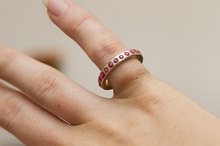Nontoxic Tattoo Ink Ingredients
Tattoos, though extremely popular, have not historically been heavily regulated. As a result, some tattoo inks have contained harmful and even toxic ingredients, ranging from metallic salts and lead to plastics, formaldehyde and a range of other chemicals 1. Today, many tattoo artists recognize the importance of using nontoxic inks in their work 1. If you want to get a tattoo, ask the artist about the ink ingredients she uses.
Safe Carriers
Although most people getting tattoos are more concerned with the color, or pigment, another critical part of the ink is the carrier. This ingredient carries the pigment into the skin, keeping the pigment evenly mixed. Although once heavily chemical-based, nontoxic versions of tattoo ink carriers today include purified water, glycerine and ethanol, all of which How-to-Tattoo.com recommends as alternatives to toxic tattoo ink carriers 1. Do not overlook the importance of carrier ingredients, not just pigments, when choosing safe tattoo inks 1.
White and Black Pigments
How to Know if You're Allergic to Tattoo Ink
Learn More
The two most popular tattoo inks, white and black pigments, can be used on their own, especially in tribal tattoos and for shading of colored tattoos 1. They have long been some of the most toxic ink colors. Black ink has traditionally been made of iron. Nontoxic versions include carbon and logwood for black ink, and titanium dioxide for white pigments.
- The two most popular tattoo inks, white and black pigments, can be used on their own, especially in tribal tattoos and for shading of colored tattoos 1.
Yellows, Greens and Blues
Nontoxic yellow tattoo ink ingredients are often based on turmeric, an herb. For greens, consider monoazo, a carbon-based pigment. Blue tattoo inks considered nontoxic include sodium and aluminum 1. Many blue dyes containing copper are also safe to use. When it comes to colored tattoo inks, avoid brightly colored or neon pigments, which are more likely to require the use of plastics and chemicals rather than natural ingredients, according to an article published by Natural News 1.
Reds and Purples
List of Toxic Ingredients Used in Vitamin Supplements
Learn More
Red pigments in tattoo ink often cause allergic reactions, attributed to iron oxide, or rust, used to obtain the right coloration. Cinnabar and cadmium red, two other common red tattoo inks, are toxic 1. Instead, look to Naphthol, although this pigment may also cause a reaction as no tattoo ink manufacturer has succeeded in making a hypoallergenic tattoo ink. For purple or violet, nontoxic tattoo ink options include dioxazine and carbazole.
- Red pigments in tattoo ink often cause allergic reactions, attributed to iron oxide, or rust, used to obtain the right coloration.
- Instead, look to Naphthol, although this pigment may also cause a reaction as no tattoo ink manufacturer has succeeded in making a hypoallergenic tattoo ink.
Nontoxic Brands
Each color and brand of ink contains completely different ingredients, according to a 2005 study at Northern Arizona University. The FDA does not regulate tattoo inks and tattoo pigments, unlike pigments used in cosmetics applied to the skin 1. Although most tattoo ink manufacturers consider their ingredient list proprietary information, some brands do release this information and make an effort to produce only nontoxic inks 1.
Related Articles
References
- How-to-Tattoo.com: Tattoo Inks
- Baylor College of Medicine BioEd Online: Is Tattoo Ink Safe?
- Natural News: The Truth About Tattoos: Health Risks, Toxicity and More
- Warshaw EM, Schlarbaum JP, Taylor JS, et al. Allergic reactions to tattoos: Retrospective analysis of North American Contact Dermatitis Group data, 2001-2016. J Am Acad Dermatol. 2019;2:e61-e62. doi:10.1016/j.jaad.2019.09.077
- Kaur RR, Kirby W, Maibach H. Cutaneous allergic reactions to tattoo ink. J Cosmet Dermatol. 2009;8:295-300. doi:10.1111/j.1473-2165.2009.00469.x
- Lynn C, Michaela, Herdrich D, et al. The evolutionary adaptation of body art: Tattoo as an honest signal of enhanced immune response in American Samoa. Amer J Hum Biol. 2019:e23347. doi:10.1002/ajhb.23347
- Wilson WT, O’Boyle M, Leach WJ. Unusual complication of a tattoo in an immunosuppressed patient. Case Reports 2018; 2018:bcr-2018-224968. doi:10.1136/bcr-2018-224968
- Oanţă A, Irimie M. Tinea on a tattoo. Acta Dermatovenerol Croat. 2016;24(3):223-4.
- Tohme RA, Holmberg SD. Transmission of hepatitis C virus infection through tattooing and piercing: a critical review. Clin Infect Dis. 2012;54:1167–1178. doi:10.1093/cid/cir991
- Centers for Disease Control and Prevention. HIV transmission. Updated August 6, 2019.
- Warshaw EM, Schlarbaum JP, Taylor JS, et al. Allergic reactions to tattoos: Retrospective analysis of North American Contact Dermatitis Group data, 2001-2016. J Am Acad Dermatol. 2019;2:e61-e62. doi:10.1016/j.jaad.2019.09.077
- Kirby W, Alston DB, Chen AH. The incidence of hypertrophic scarring and keloid formation following laser tattoo removal with a quality-switched Nd:YAG laser. J Clin Aesthet Dermatol. 2016;9(5):43–47.
- Islam PS, Chang C, Selmi C, et al. Medical complications of tattoos: A comprehensive review. Clin Rev Allergy Immunol. 2016;50(2):273-86. doi:10.1007/s12016-016-8532-0
- Valbuena MC, Franco VE, Sánchez L, Jiménez HD. Sarcoidal granulomatous reaction due to tattoos: report of two cases. An Bras Dermatol. 2017;92(5 Suppl 1):138–141. doi:10.1590/abd1806-4841.20175860
- Orzan OA, Popa LG, Vexler ES, Olaru I, Voiculescu VM, Bumbăcea RS. Tattoo-induced psoriasis. J Med Life. 2014;7 Spec No. 2(Spec Iss 2):65–68.
- Ross JR, Matava MJ. Tattoo-induced skin "burn" during magnetic resonance imaging in a professional football player: a case report. Sports Health. 2011;3(5):431–434. doi:10.1177/1941738111411698
- Kaur RR, Kirby W, Maibach H. Cutaneous allergic reactions to tattoo ink. J Cosmet Dermatol. 2009;8:295-300. doi:10.1111/j.1473-2165.2009.00469.x
- Brady BG, Gold H, Leger EA, Leger MC. Self-reported adverse tattoo reactions: a New York City Central Park study. Contact Dermatitis. 2015 Aug;73:91-99. doi:10.1111/cod.12425
- Forbat E, Al-Niaimi F. Patterns of reactions to red pigment tattoo and treatment methods. Dermatol Ther (Heidelb). 2016;6(1):13–23. doi:10.1007/s13555-016-0104-y
- Rosenbaum BE, Milam EC, Seo L, Leger MC. Skin care in the tattoo parlor: A survey of tattoo artists in New York City. Dermatology. 2016;232:484-489. doi:10.1159/000446345
- Khunger N, Molpariya A, Khunger A. Complications of tattoos and tattoo removal: Stop and think before you ink. J Cutan Aesthet Surg. 2015;8:30–36. doi:10.4103/0974-2077.155072
- United States Food and Drug Administration. Tattoos & permanent makeup; fact sheet. Oct 31, 2019.
Resources
Writer Bio
Megan Churchwell has been writing professionally since 2007, covering topics such as health and medical issues, hobbies and pets. Her articles have been published on eHow and LIVESTRONG.COM. She holds a Bachelor of Arts in American history from Willamette University.









